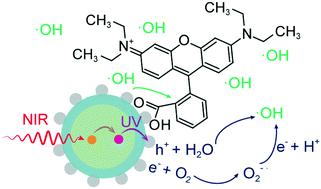当前位置:
X-MOL 学术
›
Environ. Sci.: Nano
›
论文详情
Our official English website, www.x-mol.net, welcomes your
feedback! (Note: you will need to create a separate account there.)
Synergistic effects of lanthanide surface adhesion and photon-upconversion for enhanced near-infrared responsive photodegradation of organic contaminants in wastewater
Environmental Science: Nano ( IF 5.8 ) Pub Date : 2020-09-10 , DOI: 10.1039/d0en00670j Jiaying Wang 1, 2, 3, 4, 5 , Haiying Wang 1, 2, 3, 4, 5 , Sijin Zuo 1, 2, 3, 4, 5 , Xuming Jin 1, 2, 3, 4, 5 , Bingzhu Zheng 4, 6, 7, 8, 9 , Renren Deng 4, 6, 7, 8, 9 , Weiping Liu 1, 2, 3, 4, 5 , Juan Wang 1, 2, 3, 4, 5
Environmental Science: Nano ( IF 5.8 ) Pub Date : 2020-09-10 , DOI: 10.1039/d0en00670j Jiaying Wang 1, 2, 3, 4, 5 , Haiying Wang 1, 2, 3, 4, 5 , Sijin Zuo 1, 2, 3, 4, 5 , Xuming Jin 1, 2, 3, 4, 5 , Bingzhu Zheng 4, 6, 7, 8, 9 , Renren Deng 4, 6, 7, 8, 9 , Weiping Liu 1, 2, 3, 4, 5 , Juan Wang 1, 2, 3, 4, 5
Affiliation

|
Suspended matter and organic contaminants would prevent short-wavelength UV/visible light from penetrating deeper into real wastewater. This has hindered the practical use of photocatalysts in wastewater remediation. Construction of near-infrared light responsive photocatalysts can partially overcome this issue, due to the larger penetration depth of near-infrared light into the waste media. However, the development of near-infrared responsive photocatalysts is constrained by low photoconversion efficiency. In this work, we developed an approach to enhance the performance of NIR-responsive photocatalysis of a lanthanide-doped upconversion nanoparticle–TiO2 hybrid system through coupling the surface adhesion capability of heavy lanthanides with a NIR to UV/vis light upconversion process. We demonstrated that a Gd3+-rich nanoparticle surface can enhance the adhesion of organic compounds on the heterogeneous catalysts, resulting in more complete cycloreversion of organic chromophores. We systematically investigated the photooxidation pathways of the upconversion nanoparticle–TiO2 hybrid catalysts in degradation of rhodamine B through liquid chromatography-mass spectrometry analysis. The results reveal that Gd3+ ions on the catalyst surface could facilitate the complete mineralization of the organic molecules to achieve a total organic carbon removal efficiency of around 70%, which is three times higher than that of the conventional upconversion nanoparticle–TiO2 systems. The results offer new opportunities for near-infrared light driven photocatalysis in water remediation, which is potentially applicable for large quantity deep wastewater treatment.
中文翻译:

镧系元素表面粘附和光子上转换对增强废水中有机污染物的近红外响应光降解的协同作用
悬浮物和有机污染物将阻止短波紫外线/可见光更深地渗透到实际废水中。这阻碍了光催化剂在废水修复中的实际使用。由于近红外光对废物介质的穿透深度较大,因此构建近红外光响应型光催化剂可以部分解决该问题。但是,近红外响应型光催化剂的发展受到光转化效率低的限制。在这项工作中,我们开发了一种方法来增强镧系元素掺杂的上转换纳米粒子TiO 2的近红外响应光催化性能。通过将重镧系元素的表面粘附能力与NIR耦合到UV / vis光上转换过程来实现混合系统。我们证明,富含Gd 3+的纳米颗粒表面可以增强有机化合物在非均相催化剂上的附着力,从而导致有机生色团的更完全环还原。我们通过液相色谱-质谱分析系统地研究了上转换纳米粒子-TiO 2杂化催化剂在若丹明B降解中的光氧化途径。结果表明,Gd 3+催化剂表面上的离子可以促进有机分子的完全矿化,以实现约70%的总有机碳去除效率,这是传统上转换纳米粒子– TiO 2系统的三倍。该结果为水修复中近红外光驱动的光催化提供了新的机会,这可能适用于大量的深层废水处理。
更新日期:2020-11-03
中文翻译:

镧系元素表面粘附和光子上转换对增强废水中有机污染物的近红外响应光降解的协同作用
悬浮物和有机污染物将阻止短波紫外线/可见光更深地渗透到实际废水中。这阻碍了光催化剂在废水修复中的实际使用。由于近红外光对废物介质的穿透深度较大,因此构建近红外光响应型光催化剂可以部分解决该问题。但是,近红外响应型光催化剂的发展受到光转化效率低的限制。在这项工作中,我们开发了一种方法来增强镧系元素掺杂的上转换纳米粒子TiO 2的近红外响应光催化性能。通过将重镧系元素的表面粘附能力与NIR耦合到UV / vis光上转换过程来实现混合系统。我们证明,富含Gd 3+的纳米颗粒表面可以增强有机化合物在非均相催化剂上的附着力,从而导致有机生色团的更完全环还原。我们通过液相色谱-质谱分析系统地研究了上转换纳米粒子-TiO 2杂化催化剂在若丹明B降解中的光氧化途径。结果表明,Gd 3+催化剂表面上的离子可以促进有机分子的完全矿化,以实现约70%的总有机碳去除效率,这是传统上转换纳米粒子– TiO 2系统的三倍。该结果为水修复中近红外光驱动的光催化提供了新的机会,这可能适用于大量的深层废水处理。











































 京公网安备 11010802027423号
京公网安备 11010802027423号